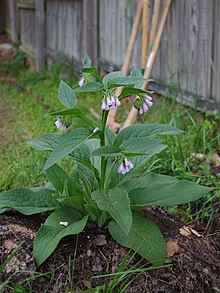Symphytum
| Symphytum | |
|---|---|

| |
| Symphytum caucasicum | |
| Scientific classification | |
| Kingdom: | Plantae |
| Clade: | Tracheophytes |
| Clade: | Angiosperms |
| Clade: | Eudicots |
| Clade: | Asterids |
| Order: | Boraginales |
| Family: | Boraginaceae |
| Subfamily: | Boraginoideae |
| Genus: | Symphytum L. |
| Type species | |
| Symphytum officinale L.
| |
| Species | |
|
See text. | |
Symphytum is a
Species
Species include:
- Symphytum asperum – prickly comfrey, rough comfrey
- Symphytum bulbosum – bulbous comfrey
- Symphytum brachycalyx – Palestine comfrey
- Symphytum caucasicum – Caucasian comfrey
- Symphytum grandiflorum – creeping comfrey
- Symphytum ibericum – Iberian comfrey[3]
- Symphytum officinale – comfrey
- Symphytum orientale – white comfrey
- Symphytum tauricum – Crimean comfrey
- Symphytum tuberosum – tuberous comfrey
- Symphytum × uplandicum (S. asperum × S. officinale, synonym: S. peregrinum) – Russian comfrey, healing herb, blackwort, bruisewort, wallwort, gum plant


Cultivation
The Russian comfrey 'Bocking 14' cultivar was developed during the 1950s by
Propagation
This section needs additional citations for verification. (May 2018) |
Bocking 14 is sterile, and therefore will not set seed (one of its advantages over other cultivars as it will not spread out of control); thus, it is propagated from
Phytochemistry, folk medicine, and toxicity
Folk medicine names for comfrey include knitbone, boneset, and the derivation of its Latin name Symphytum (from the Greek symphis, meaning growing together of bones, and phyton, a plant), referring to its ancient uses. Similarly, the common French name is consoude, meaning to weld together. The tradition in different cultures and languages suggest a common belief in its usefulness for mending bones.
Comfrey contains mixed
In 2001, the United States Food and Drug Administration issued a ban of comfrey products marketed for internal use, and a warning label for those intended for external use. [10] [11] Comfrey is particularly contraindicated during pregnancy and lactation, in infants, and in people with liver, kidney, or vascular diseases.[6][12]
References
- ^ WFO (2022): Symphytum L. Published on the Internet; http://www.worldfloraonline.org/taxon/wfo-4000037231. Accessed on: 14 Dec 2022
- ^ USDA, NRCS (n.d.). "Cynoglossum virginianum". The PLANTS Database (plants.usda.gov). Greensboro, North Carolina: National Plant Data Team. Retrieved 2018-11-20.
- ^ "Symphytum ibericum". rhs.org.uk. Retrieved 23 April 2017.
- ^ Alfrey, Paul (3 June 2016). "Comfrey – BELIEVE the HYPE!". Permaculture Research Institute. Retrieved 1 June 2021.
- ^ Teynor, Putnam, Doll, Kelling, Oelke, Undersander, and Oplinger. "Comfrey". Alternative Field Crops Manual. University of Wisconsin, Extension, Cooperative-Extension. Retrieved 25 March 2014.
{{cite web}}: CS1 maint: multiple names: authors list (link) - ^ a b c d "Comfrey". Drugs.com. 17 July 2017. Retrieved 22 May 2018.
- PMID 21170807.
- PMID 2399473.
- PMID 9818800.
- ^ "FDA/CFSAN – FDA Advises Dietary Supplement Manufacturers to Remove Comfrey Products From the Market (archived copy)". Food and Drug Administration. Retrieved 2023-06-12.
- PMID 14518351.
- S2CID 42511497.
External links
- Giannetti, B. M.; Staiger, C.; Bulitta, M.; Predel, H.-G. (1 July 2010). "Efficacy and safety of comfrey root extract ointment in the treatment of acute upper or lower back pain: results of a double-blind, randomised, placebo controlled, multicentre trial". British Journal of Sports Medicine. 44 (9): 637–641. S2CID 5432523.
